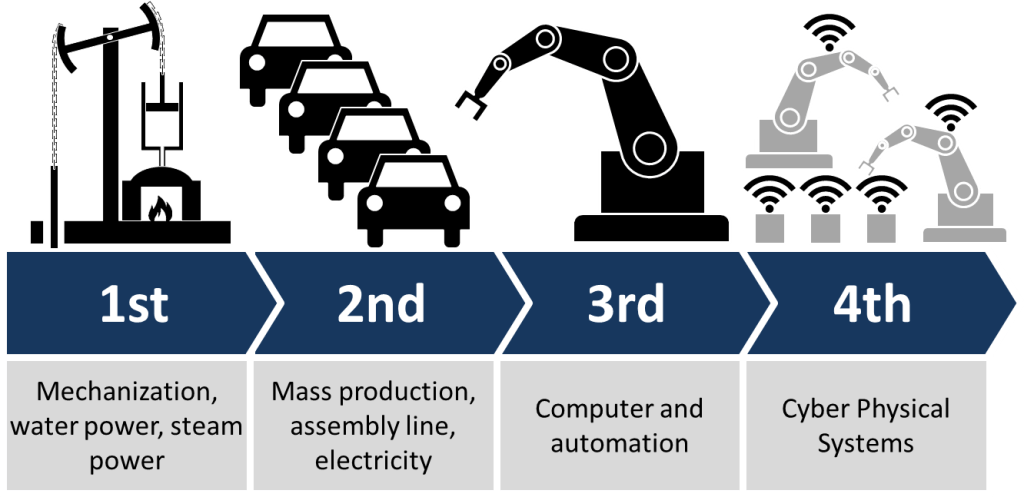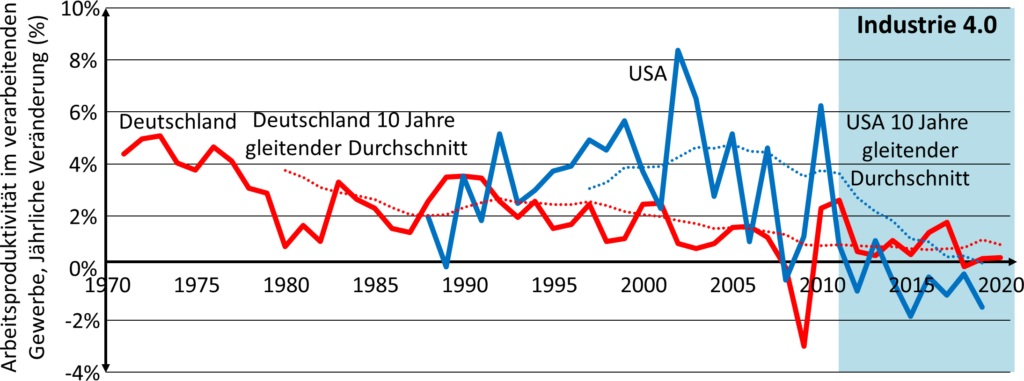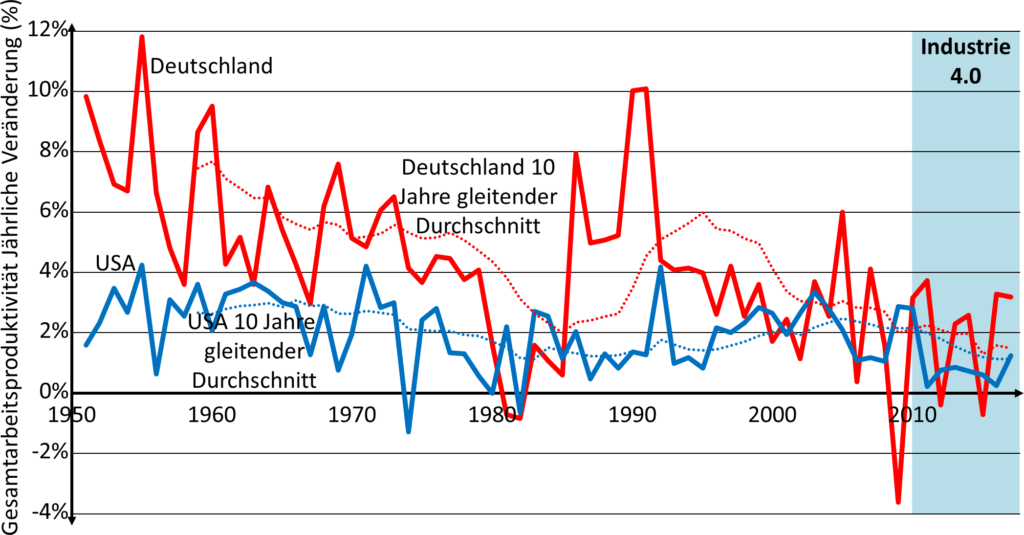 Pretty much ten years ago, in April 2011, Industry 4.0 was first presented to the audience at the Hannover Messe in Germany. Industry 4.0 made lots of promises about everything getting better and easier. But, <surprise Pikachu>, it did not. Let’s have a look.
Pretty much ten years ago, in April 2011, Industry 4.0 was first presented to the audience at the Hannover Messe in Germany. Industry 4.0 made lots of promises about everything getting better and easier. But, <surprise Pikachu>, it did not. Let’s have a look.
Introduction
Industry 4.0 is (supposedly) the fourth industrial revolution after the first (mechanization and steam power), the second (electricity and mass production), and the third (computer). Networking everything will (supposedly) solve a lot of problems. If you are a regular reader, you know that I am somewhat skeptical of a lot of these claims. See also my posts A Critical Look at Industry 4.0 and Industry 4.0 – What Works, What Doesn’t.
A Look at Productivity
In this post (inspired by a German article, source below) I am looking at the impact of Industry 4.0 on manufacturing. Usually, improvement in manufacturing is measured as labor productivity (i.e., how much goods a worker can produce in a given time). For countries this is usually measured as a monetary value per worker or per worker-hour. Luckily, these statistics are readily available.
The graph below shows the annual percentage change in manufacturing labor productivity in Germany (available data 1970–2020 Source) and the USA (available data 1987–2019 Source), including the ten-year moving averages (dotted lines). I also indicated the period when Industry 4.0 became a buzzword, which is from 2011 onward (albeit the topic is – frankly – not new).
If you are a strong believer in Industry 4.0, you may have expected a stronger growth due to the… well… revolution going on. In fact, the opposite is happening. Manufacturing productivity growth during the last ten years was definitely lower than in the decades before, and sometimes even negative. It almost looks like “the revolution” is slowing productivity.
Going a bit further back to the 1950s, the graph below shows you the overall labor productivity (not only manufacturing) for both Germany and the USA, again including the ten-year moving average as a dotted line and showing the period of Industry 4.0 (source).
Since this graph merges all productivity (besides manufacturing, also agricultural, services, mining, etc.), the effect is no longer as pronounced, but still there. Productivity growth in Germany is the lowest since World War II, and US productivity is not so hot either. But most decidedly there is not any uptick visible. What happened to the promised improvement from our new revolution? To be fair, there are lots of other factors that can affect productivity, from orange presidents to viral pandemics. But overall, the impact of Industry 4.0 on manufacturing is still disappointing.
Why Is There No Revolution?

Clearly, there is no revolution. If anything, productivity growth is less than before. In my previous posts I wrote a lot on caution when dealing with the Industry 4.0 hype. Some things work, but a lot of things don’t. And you need to do thorough PDCA to make sure it does work. As well, it is much easier to sell the hype together with software, services, or consulting, than it is to actually provide bottom-line results.

I believe Industry 4.0 is profitable for software vendors, service providers, and consultants, but only sometimes for the actual manufacturer. It is like a gold rush, were your best bet on making money is to sell shovels, and a possible way to lose money is to dig for gold. Some people DO get rich, but most don’t.
It is the same in manufacturing. Some companies benefit immensely from Industry 4.0, but I believe the majority of companies are better off being followers than leaders. It also depends on how you interpret Industry 4.0 (You’re using email? Hey, you are a digitally networked cyber-physical Industry 4.0 company! … or maybe not)
One of my colleagues, Steffen Kinkel, believes that companies put effort into digital systems but neglect to solve the fundamental problems on the shop floor. Putting a digital twin on an inefficient process does not magically make the process efficient. Data can help in making it efficient, but you still need to put in the effort to improve the underlying process. Unfortunately, many companies skip on this actual improvement part in favor of more digitization and more data … which they then don’t use either.
 But there is still a lot of improvement potential. One German study, Wertschöpfungspotenziale 4.0 (source below), finds still 95 billion Euro potential for improvement in the German industry by using lean manufacturing, or roughly 14%. Personally I think there will be more, but that is just a hunch. Unfortunately, investment in improvements and new equipment is reduced in favor of research and also digital toys… sorry… tools. But while painting a car makes it look nicer, it does not fix the broken engine.
But there is still a lot of improvement potential. One German study, Wertschöpfungspotenziale 4.0 (source below), finds still 95 billion Euro potential for improvement in the German industry by using lean manufacturing, or roughly 14%. Personally I think there will be more, but that is just a hunch. Unfortunately, investment in improvements and new equipment is reduced in favor of research and also digital toys… sorry… tools. But while painting a car makes it look nicer, it does not fix the broken engine.
 Investing in research, of course, is valuable. But you also need to actually make the product. This is, I think, part of the German mentality. We love to engineer, design, and make blueprints. But the building of the product is more of a hassle that has to be done. (It is different in Japan, where the art of making things is part of the Japanese culture). It should be obvious that for a company to be successful, you need a combination of different factors. You need research, design, sales, AND manufacturing. The weakest link will limit your success. With all the glitzy digital companies from Google to Facebook, manufacturing does look old-fashioned and boring to some. But this is wrong. Both the Roman and the Chinese Empire fell far short of their potentials because manufacturing was left to the slaves and those not smart enough for politics or military (trust me, I wrote the book on this).
Investing in research, of course, is valuable. But you also need to actually make the product. This is, I think, part of the German mentality. We love to engineer, design, and make blueprints. But the building of the product is more of a hassle that has to be done. (It is different in Japan, where the art of making things is part of the Japanese culture). It should be obvious that for a company to be successful, you need a combination of different factors. You need research, design, sales, AND manufacturing. The weakest link will limit your success. With all the glitzy digital companies from Google to Facebook, manufacturing does look old-fashioned and boring to some. But this is wrong. Both the Roman and the Chinese Empire fell far short of their potentials because manufacturing was left to the slaves and those not smart enough for politics or military (trust me, I wrote the book on this).
In sum, Industry 4.0 is NOT a shortcut to solve problems, but at best an aid. It does not magically solve problems and make you better. You still need to take care of all the little things on the shop floor. Overall, we continue to need manufacturing, and to invest and improve manufacturing, to be successful. Now, go out, fix some problems on the shop floor, and organize your industry!
Source
This blog post was inspired by an article from the German magazine Heise “Zehn Jahre Industrie 4.0: Null Produktivitätsfortschritt“, written by Alexander Horn, which was pointed out to me by Dr. Tom Drews. Many thanks, Tom! This article is based on the (also German) report “Wertschöpfungspotenziale 4.0” by Steffen Kinkel, Sebastian Beiner, Arndt Schäfer, Heidi Heimberger, and Angela Jäger.




Thank you, Prof Roser, for this article.
Thought provoking indeed.
At the end of the day, it seems “only the fundamentals matter. Need to get THAT right upfront”.
On a similar note, would like to hear your thoughts on Lean vs Industrial Engineering, or is Lean out-dated, in favour of Industrial System Engineering….
There must be some synergy, somewhere.
Regards
Ben
I believe it was around the mid 1990’s when a US colleague asked me what difference computers, IT etc. had made to productivity. Frankly, I’d never given it a thought, and had only just acquired my first laptop (a neat little Canon with a built-in printer!).
He told me: none.
How sure are you that the measurement is correct? Is $/man hour really the best way to measure productivity? If a society actually becomes more productive, don’t goods just become cheaper thereby hiding (according to that metric) any hint of a gain in the first place?
Hello Lucas, different countries measure differently, of course. But within the country the data is usually consistent. (Note: German Reunification in 1990 changed the underlying data somewhat). There are also different ways to measure productivity, usually some quantity per time. This could be process time, machine time, or worker time. the last is usually more of interest in connection to I4.0, since I4.0 wants to produce more through automation, requiring less labor.
Inflation usually makes things more expensive, although most manufactured products can resist inflation and even become cheaper. See for example my post Manufacturing Drives Prosperity.
I remember working for a large HVAC automotive supplier, who were talking about IoT, and lots of really clever (expensive), networked systems. Meanwhile the shop floor was full of WIP. The didn’t even have a simple pull system running, or any automatic link between orders and production scheduling (it was all manual). Even worse, shop floor efficiency was measured against units produced instead of ‘units required for sales’ produced. WIP just kept getting bigger.
Industry 4.0 is not going to fix a basic lack of common sense.
Indeed a difficult subject. Clearly the Continuous Process Improvement cannot be replaced by Technology. It can only be helped.
On the other side, what is not clear, is how many Industries have indeed moved to 4.0. In many cases it is only a marketing advertisement rather than a real transformation, which should be the case.
In a real Industry 4.0 level, the Human error is practically eliminated or significantly reduced. The communication gets simplified and the flow becomes transparent, making easy to spot not the failure but even better the precursors of a potential failure.
Such a transformation in many cases is Capital intensive and would require even some Engineering evolution. Considering the market difficulties, especially after 2008, the Financials may be the reason that Industry 4.0 has been announced but not yet arrived.
Hello Miltiadis, with the current state of I4.0 it may even be good that few companies are implementing I4.0, since it will work only for few of them.
Great post Professor Roser! I am currently studying Supply Chain at URI and I have found your blog very intriguing to read and learn from. In your post, I believe you highlighted the most important part of Industry 4.0 and that is how it is interpreted from industry to industry. Also, I liked reading what you believe Industry 4.0 was and what it was not. I came away with a better understanding of it overall.
My opinion:
It is the opposite of a solution to put a complex software on a complex shop floor/system. Things will get worse rather than better.
Simplification is key. Spend your money and time to improve the reality/shop floor and maybe you will reach the point where these software solutions are able to help you.
Hello Alexander, very well said. A I4.0 system on top of a confusing & complex manufacturing system will not improve the manufacturing system. If the I4.0 is also confusing and complex, it may even make things worse.
Hi Christoph
In my opinion, the whole debate about industry 4.0 doesn´t help an active SME (for germans KMU).Still today, a lot of missing productivity is related to the fact, that owners/managers do not like to change the work since 30 years plus. If there is no CIP, no common sense used and workers are not included in the day to day business, industry 4.0 will definitely not help being more productive. First of all workplaces, materialflow, inventories and quality-aspects need to be looked at and people need to understand the basics of Lean, than, step by step a more digitalized process can help making improvements. But more than 70% of all midsized companies are still far away from that.
Well said, Gerhard. I see I4.0 a bit like driving a car. If you have never driven a car before and start with the fanciest car there is, then it can become quite expensive quickly. Maybe they should start with a bicycle, before taking a driving course in a save environment, followed by a few years as a novice driver, before they can actually drive well.
Hello Christoph,
you definitely hit the point. Well written and said.
Greetings Holger
Hello Holger, Many thanks! Good to hear from you.
Thanks for sharing this post! It’s important to look at whether things we think are going to be productive end up actually being productive. I agree that adding technology to a process does not automatically make the process efficient, especially because some efficiency problems can be solved without new technology.
hello. thanks for the comprehensive reporting on topic 4.0.
I myself notice these matters as you mention them. of course these systems do nothing good or add added value if the base is still there when it was, there are still the same problems on the lines when they were either with 4.0 or without it.
and I totally agree it’s not for everyone, well since not at the moment.
i think this process needs to be built slowly, and it is equally important for people to accept it as their own.
otherwise the marketing praise itself is _eh but we have it. but in fact it does not bring you any added value.
Thank you again
OMitja, I agree that I4.0 has potential, but also a lot of dangers. thanks for your confirmation from your industry 🙂
I cannot agree more…
Somehow I feel more and more managers chose Industry 4.0 technology, because they want to stay inside the nice office with air-con, open the computer, and get everything about their plants…without having a daily Gemba walk.
But in the reality, the wastes will always be there no matter what technology you use.
Hello Christopher,
could it be, that the source-link is not actual anymore? “Germany (available data 1970–2020 Source)” I would be curious on the background data.
Thank you for giving this insight.
Best regards from the Black Forest,
Philip
Hi Philip, yes, the link seems to have changed. I looked up the data with the Deutsches Bundesamt and changed the link. This *should* be the same data.